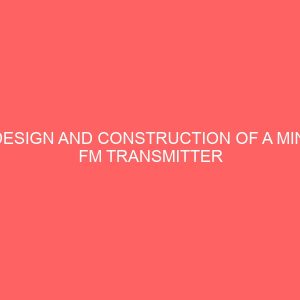Description
CHAPTER ONE
1.0. GENERAL INTRODUCTION
1.1. AN OVER VIEW OF MODULATION:
This research is on Design and construction of a mini FM transmitter. In communication engineering, modulation is a very important process. FM transmission is therefore not possible without modulation and this process of modulation is achieved through the use of transmitter
Here, modulation is seen as the process of combining the low frequency signal with a very high frequency radio wave called carrier wave and the resultant wave produced is called modulated wave.
1.1.1.THE NEED FOR MODULATION:
Sometimes, beginners question the necessity of modulation i.e. using a carrier wave to the low frequency signal from one place to another. Why not transmit the signal directly and save lot of botheration Unfortunately, there are three main hurdles in the process of such direct transmission of radio frequency signals
I. They have relatively short range
II. If everybody started transmitting these low frequency signals directly, mutual interference will render all of them ineffective.
III. Size of antenna required for their efficient radiation will be too large.
1.1.2.TYPES OF MODULATION:
There are three types of modulation, these includes;
I. AMPLITUDE MODULATION: Here, the information or AF signal changes the amplitude of the carrier wave without changing its frequency phase.
II. FREQUENCY MODULATION: In these case, the information signal changes the frequency of the carrier wave without changing the amplitude or phase.
III. PHASE MODULATION: Here the information signals changes the phase of the carrier wave without changing other two parameters.
1.1.3.ADVANTAGES OF FM OVER AM TRANSMITTER:
I. Wave at higher frequencies can carry more data than waves at low frequency.
II. Smaller geographical interference between neighboring stations.
III. Less radiated power.
IV. Well defined service areas for a given transmitter power.
1.2. PURPOSE OF THE STUDY:
The main aim of this project is to construct an FM transmitter Frequency modulated transmitter that can be used in telecommunication laboratory experiment.
Every day of our work and in our free time, we come in contact with and used a variety of modern communication system and communication media, the most common being the telephone, radio, television and internet. Through these media, we are able to communicate with people in different continent and transact our daily business and received information about various development and events of note and that occurs all around the world.
The main purpose of any radio communication system is to transmit intelligence from one point or place to another. Communication may be unidirectional as in the case of sound and television broadcasting or it may be bidirectional with most radio television system. At the transmitting of the system, the signal must modulate a suitable carrier frequency spectrum and then be amplified to the necessary transmitter power level.
1.3. STATEMENT OF PROBLEM:
Frequency modulation transmitter is one of the basic equipment required in telecommunication laboratories. The department of Electrical Electronic Fidel Polytechnic Gboko has over the years has been suffering from shortage of frequency modulated transmitter for practical uses. These has really hindered the students from acquiring the basic knowledge of frequency modulation FM because all students cannot operate the available equipment at the same time owing to the fact that students are too many to work on a single transmitter, they get discouraged and refuse to concentrate on these practical.
In a bid to find solution to this problem, the idea of increasing the number of such transmitter was initiated with the hope of finding a testing solution to this problem.
CHAPTER TWO
2.0. LITERATURE REVIEW:
2.1. FM TRANSMITTER BACKGROUND:
There has been the growing need to send information over a long distance and quickly too. Overtime, various attempts have been made not justify this need, but to accomplish it with ease. Both for the sender or the source and the receiver or the destination these attempt have include those of the town criers and their local drums from the beginning of human history then the wired telephone in the eighteen forties 1840s and some decades later at the dawn of the 21st century the use of radio waves in the wireless communication system.
Great advancement in all fields of human endeavor science, politics economics, etc. of the modern electric based wireless communication system.
Among other things, it enables the human voice to be sent to great distances using the carrier wave at a modulated frequency of 88 108MHZ and received on a suitable FM receiver.
The frequency modulation transmitter according to Jersey 1992 is an electromagnetic circuit designed with input and output transducer which convert, amplify, and transmit audio signals to the receivers destination.
The transmitter modulates a carrier wave by intelligence and radiates the modulated signals through an antenna and demodulates it to obtain or receive the original intelligence.
2.2. COMPONENT OF AN FM TRANSMITTER AND THEIR FUNCTIONS
I. OSCILLATION STAGE: An oscillator is a circuit which generates an AC output signal without requiring any external applied input signal. The main functions of all oscillators in this work it to produce sinusoidal wave shapes of a specific frequency and amplitude. In doing so, the stability of an oscillator is very important.
II. DC POWER SUPPLY: A DC power supply is an electric circuit that is used to convert an input AC voltage into a stable output voltage in the form of DC. The function of a DC power supply in this work is that it provides direct current.
III. MICROPHONE: A microphone is a form of an electromechanical transducer, it convert sound wave of varying air pressure into electric audio signal and voice sound is coupled into the system by the microphone. The function of a microphone here is to convert the pressure waves coursed by sound into vibrations within a coil which transforms the vibration.
IV. MODULATOR: A modulator is an object that converts the information encoded in a signal into another code. It can either be digital or analogue. The main reason for doing this is that transmission of the signal is usually more optimum in the coded form than the non encoded form. The main function of the modulator in this work is that it converts the video or audio output of a DVD player.
V. AUDIO AMPLIFIER STAGE: The audio amplifier stage is a circuit of class A amplifier designed to amplify very weak signal such as the audio frequency AF from the microphone output. This amplifier is necessary for the purpose of transmission. The main function of audio amplifier is considered as important element of audio tracks that documents the equipment. The audio amplifier is basically designed to get used to play the audio track from bands.
VI. RF AMPLIFIER: This frequency modulated signal is further amplified to a higher frequency before it is coupled to the Antenna for transmission. The class C amplifier is used as it is the most suitable type of the amplifier for high power output at radio frequency. The function of RF amplifier in this work is that it improves selectivity i.e. rejection of unwanted signal.
VII. ANTENNA: Antenna is a device that radiates radio frequency energy in responses to an applied voltage and the associated alternating electric circuit in it and a voltage between its terminals. The main function of the antenna in this work is to radiate electromagnetic energy into space.







Reviews
There are no reviews yet.